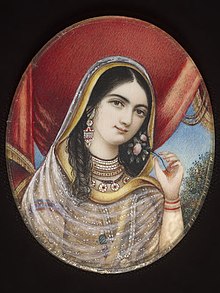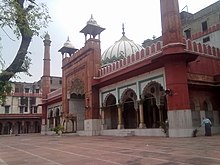Zeenat-un-Nissa
Zeenat-un-Nissa (Persian: زینت النساء 5 October 1643 – 7 May 1721) was a Mughal princess and the second daughter of Emperor Aurangzeb and his chief consort Dilras Banu Begum. Her father conferred upon her the honorable title of Padshah Begum.[1] Princess Zeenat-un-Nissa is known by historians for her piety and extensive charity.[2]:14,318
| Zeenat-un-Nissa | |
|---|---|
| Shahzadi of the Mughal Empire | |
 A Depiction of Zeenat-un-nissa begum also called Padshah Begum | |
| Padshah Begum | |
| Tenure | 1681-1721 |
| Predecessor | Jahanara Begum |
| Successor | Badshah Begum |
| Born | 5 October 1643 Aurangabad, Mughal Empire |
| Died | 7 May 1721 (aged 77) Delhi, Mughal Empire |
| Burial | Zeenat-ul-Masjid, Delhi |
| House | Timurid |
| Father | Aurangzeb |
| Mother | Dilras Banu Begum |
| Religion | Islam |
Biography
Zeenat-un-Nissa ("Jewel among Women") was born on 5 October 1643, probably in Aurangabad to Dilras Banu Begum, Aurangzeb's first wife and chief consort. Her mother was a princess of the prominent Safavid dynasty of Persia and was a daughter of Mirza Badi-uz-Zaman Safavi, the Viceroy of Gujarat.[3] Her paternal grandfather was the fifth Mughal emperor Shah Jahan during whose reign she was born. Zeenat had in-depth knowledge of the doctrines of Islam, just like her elder sister, Princess Zeb-un-Nisa and her younger sister, Princess Zubdat-un-Nissa.[4] She was educated by private tutors and scholars, and refused to marry, choosing to remain single her entire life.
Zeenat was a partisan of her youngest step-brother, Muhammad Kam Bakhsh, for whom she gained pardon from her father on several occasions. Though her full brother, Azam Shah, had a strong disliking for him.[5] Zeenat was her father's sole companion during the later part of his reign, along with his concubine Udaipuri Mahal. She was the superintendent of her father's household in the Deccan for a quarter of a century till his death in 1707. She survived him many years, enjoying the respect of his successors as the living memorial of a great age.[2]:282
Death
She had the Zeenat-ul-Masajid ("Ornament of Mosques") constructed at her expense in c.1700 by the riverside wall of the Red Fort in Delhi, where she was buried.[6]

Ancestry
| Ancestors of Zeenat-un-Nissa | |||||||||||||||||||||||||||||||||||||||||||||||||||||||||||||||||||||||||||||||||||||||||||||||||||||||||||||||||||||||||||||||||||||||||||||||||||||||||||||||||||||||||||||||||||||||||||||||||||||||||||||||||||||||||||||||||||||||||||||||||||||||||||||||||||||||||||||||||||||||||||||||||||||||||||||||||||||||||||||||||||||||||||||||||||||||||||||||||||||||||||||||||||||||||||||||||||||||||||||||||||||||||||||||||||||||||||||||||||||||||||||||||||||||||||||||||||||||||||||||||||||||||||||||||||||||||||||||||||||||||||||||||||||||||||||
|---|---|---|---|---|---|---|---|---|---|---|---|---|---|---|---|---|---|---|---|---|---|---|---|---|---|---|---|---|---|---|---|---|---|---|---|---|---|---|---|---|---|---|---|---|---|---|---|---|---|---|---|---|---|---|---|---|---|---|---|---|---|---|---|---|---|---|---|---|---|---|---|---|---|---|---|---|---|---|---|---|---|---|---|---|---|---|---|---|---|---|---|---|---|---|---|---|---|---|---|---|---|---|---|---|---|---|---|---|---|---|---|---|---|---|---|---|---|---|---|---|---|---|---|---|---|---|---|---|---|---|---|---|---|---|---|---|---|---|---|---|---|---|---|---|---|---|---|---|---|---|---|---|---|---|---|---|---|---|---|---|---|---|---|---|---|---|---|---|---|---|---|---|---|---|---|---|---|---|---|---|---|---|---|---|---|---|---|---|---|---|---|---|---|---|---|---|---|---|---|---|---|---|---|---|---|---|---|---|---|---|---|---|---|---|---|---|---|---|---|---|---|---|---|---|---|---|---|---|---|---|---|---|---|---|---|---|---|---|---|---|---|---|---|---|---|---|---|---|---|---|---|---|---|---|---|---|---|---|---|---|---|---|---|---|---|---|---|---|---|---|---|---|---|---|---|---|---|---|---|---|---|---|---|---|---|---|---|---|---|---|---|---|---|---|---|---|---|---|---|---|---|---|---|---|---|---|---|---|---|---|---|---|---|---|---|---|---|---|---|---|---|---|---|---|---|---|---|---|---|---|---|---|---|---|---|---|---|---|---|---|---|---|---|---|---|---|---|---|---|---|---|---|---|---|---|---|---|---|---|---|---|---|---|---|---|---|---|---|---|---|---|---|---|---|---|---|---|---|---|---|---|---|---|---|---|---|---|---|---|---|---|---|---|---|---|---|---|---|---|---|---|---|---|---|---|---|---|---|---|---|---|---|---|---|---|---|---|---|---|---|---|---|---|---|---|---|---|---|---|---|---|---|---|---|---|---|---|---|---|---|---|---|---|---|---|---|---|---|---|---|---|---|---|---|---|---|---|---|---|---|---|---|---|---|---|---|---|---|---|---|---|---|---|---|---|---|---|---|---|---|---|---|---|---|---|---|---|---|---|---|---|---|---|---|---|---|---|---|---|---|---|---|---|---|---|---|---|---|---|---|---|---|---|---|---|---|---|---|---|---|---|---|---|---|---|---|---|---|---|---|---|---|---|---|---|---|---|---|---|---|---|
| |||||||||||||||||||||||||||||||||||||||||||||||||||||||||||||||||||||||||||||||||||||||||||||||||||||||||||||||||||||||||||||||||||||||||||||||||||||||||||||||||||||||||||||||||||||||||||||||||||||||||||||||||||||||||||||||||||||||||||||||||||||||||||||||||||||||||||||||||||||||||||||||||||||||||||||||||||||||||||||||||||||||||||||||||||||||||||||||||||||||||||||||||||||||||||||||||||||||||||||||||||||||||||||||||||||||||||||||||||||||||||||||||||||||||||||||||||||||||||||||||||||||||||||||||||||||||||||||||||||||||||||||||||||||||||||
See also
References
- Sir Jadunath Sarkar (1973). Volumes 1-2 of History of Aurangzib: Mainly Based on Original Sources. Orient Longman. p. 38.
- Sir Jadunath Sarkar (1979). A short history of Aurangzib, 1618-1707.
- Annie Krieger-Krynicki (2005). Captive princess: Zebunissa, daughter of Emperor Aurangzeb. Oxford University Press. p. 1.
- Schimmel, Annemarie (1980). Islam in the Indian Subcontinent, Volume 2, Issue 4, Part 3. Leiden: Brill. ISBN 9789004061170.
- Richards, J.F. (1995). Mughal empire (Transferred to digital print. ed.). Cambridge, Eng.: Cambridge University Press. ISBN 9780521566032.
- Annemarie Schimmel, Burzine K. Waghmar (2004). The Empire of the Great Mughals: History, Art and Culture. Reaktion Books. p. 154.